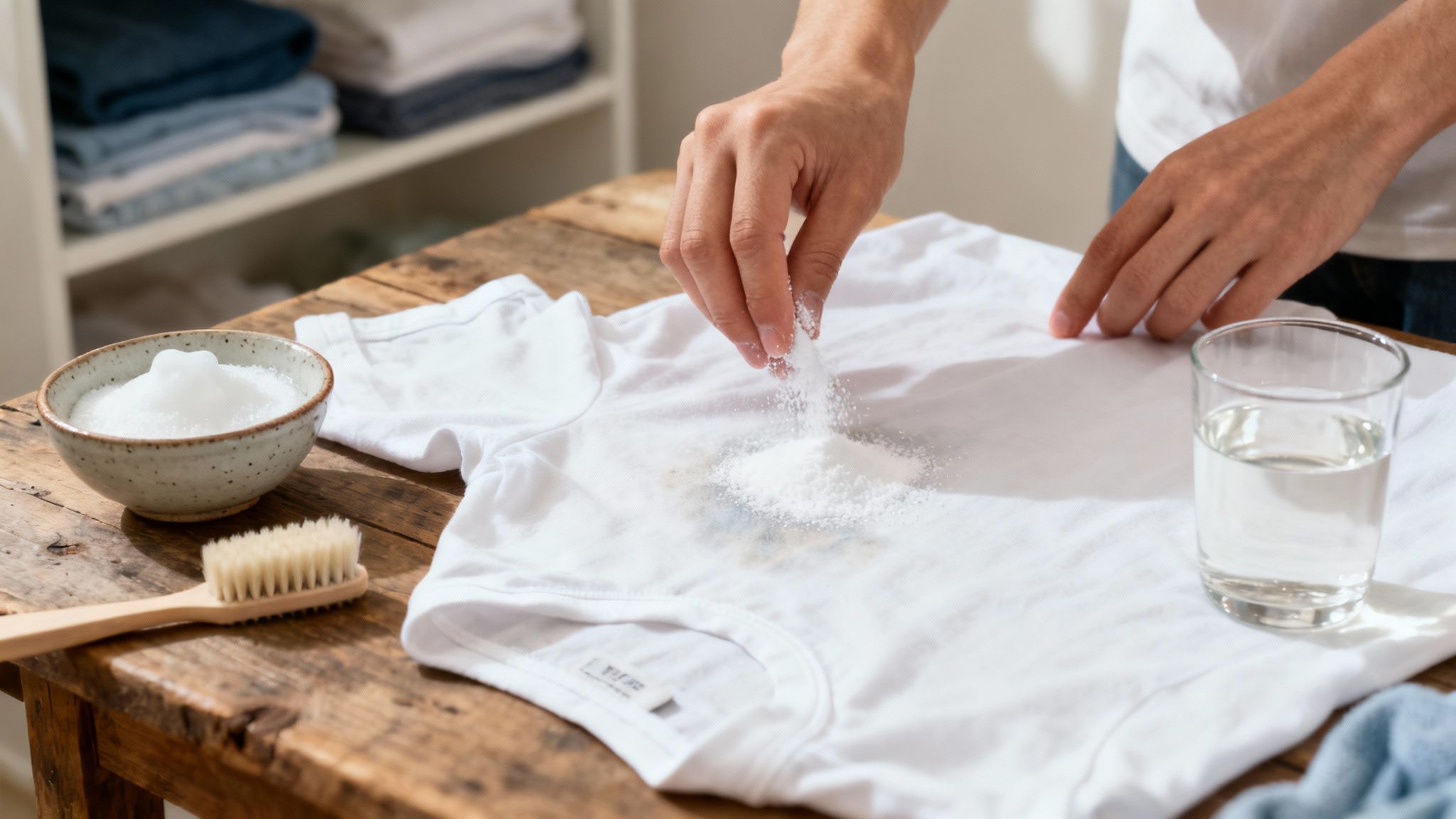how to remove deodorant stains from shirts: quick fixes
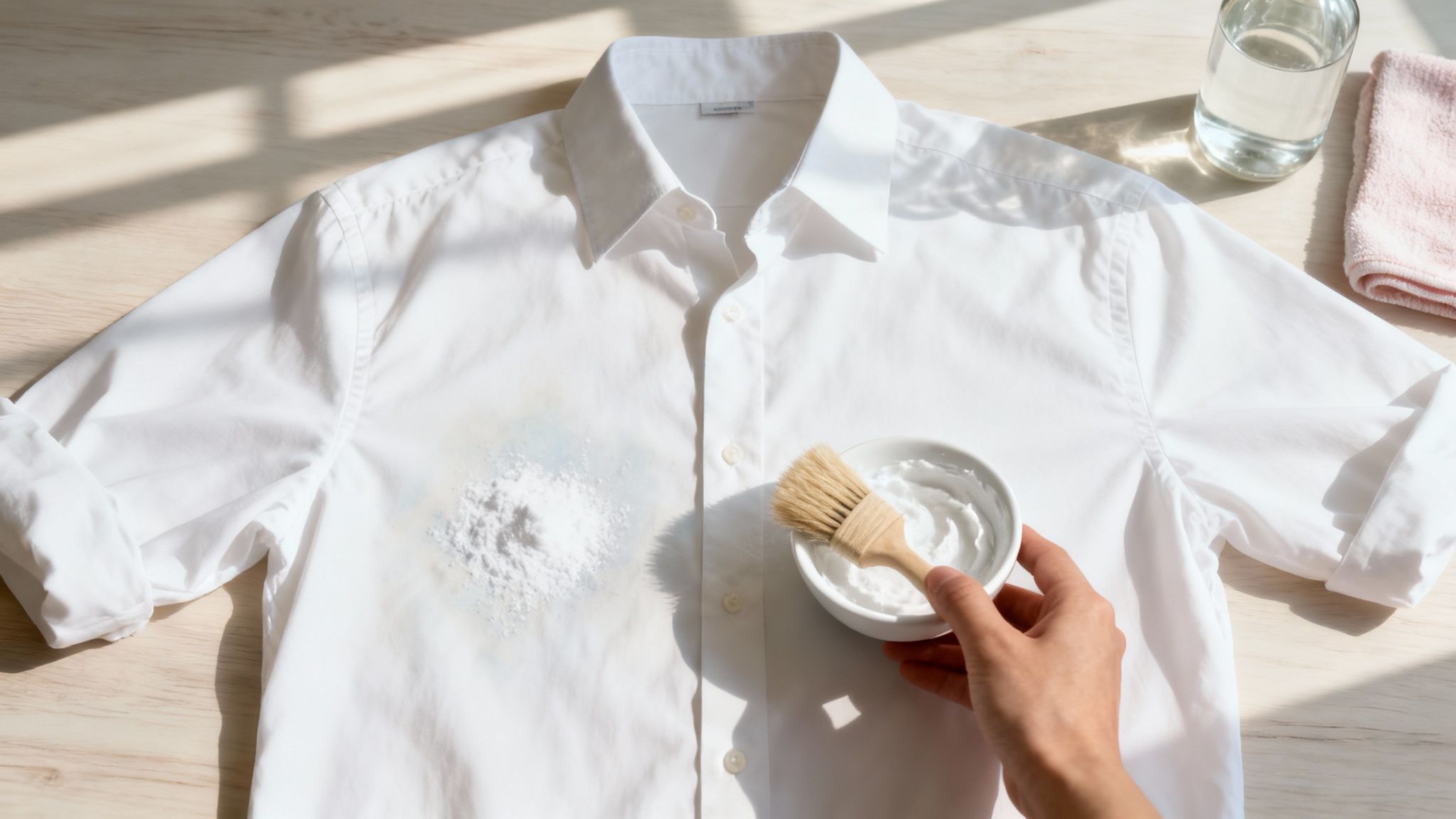
We’ve all been there. You’re about to head out the door, you throw on your favorite black shirt, and… white streaks. Ugh. Or maybe you pull a classic white tee from the drawer only to find those dreaded, stiff yellow pit stains. Good news: both are totally fixable.
The trick is knowing what kind of stain you're dealing with. A fresh, chalky white streak needs a different approach than a deep-set yellow stain that’s chemically bonded with the fabric over time.
Your Quick Guide to Beating Deodorant Stains
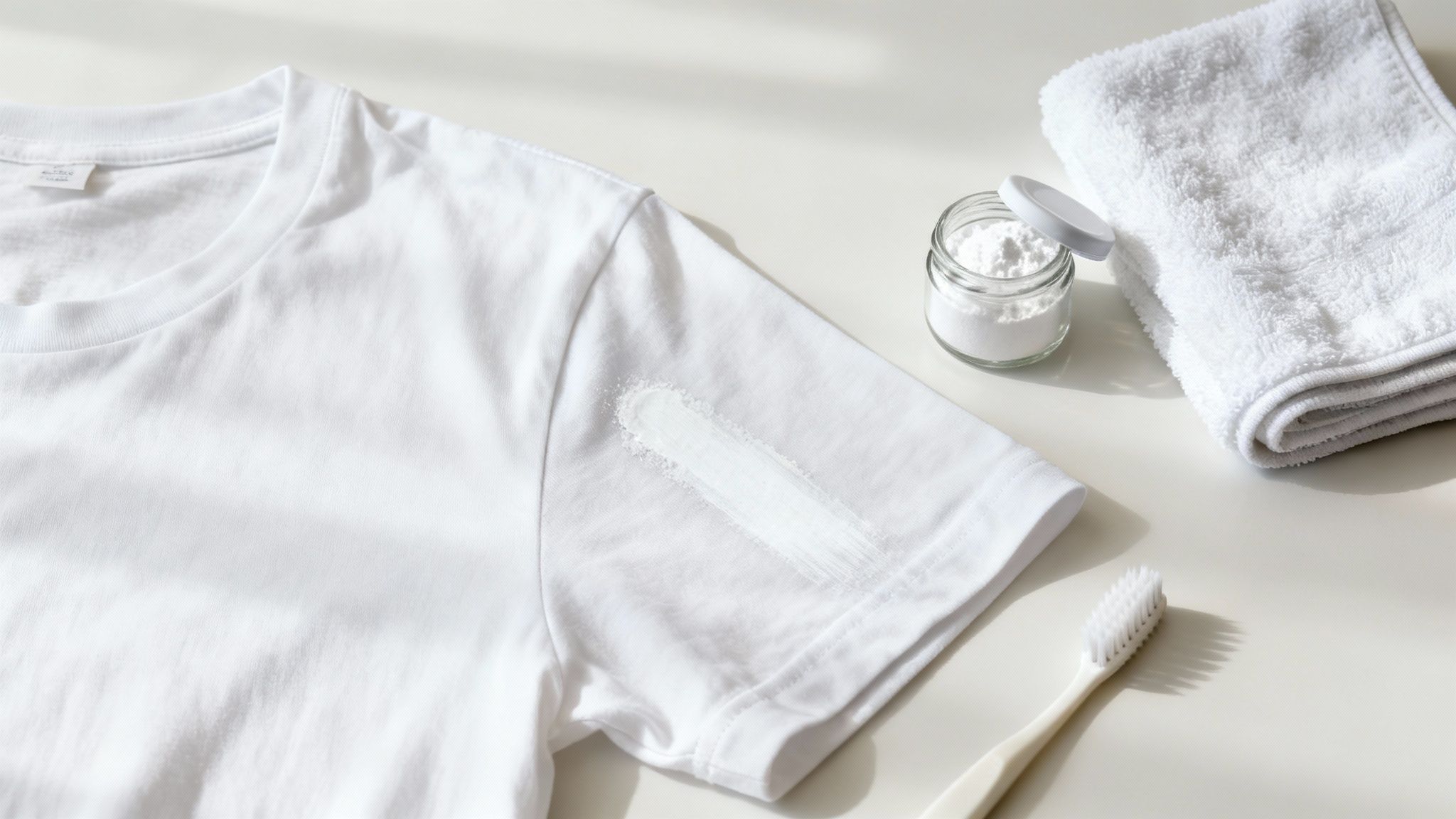
Before we get into the heavy-duty methods, let's cover the basics. Think of this as your immediate action plan for tackling those pesky marks the moment you spot them. The faster you act, the better your chances of getting the stain out completely.
This little table is your cheat sheet for identifying the stain and knowing exactly what to do first. No guesswork needed.
Deodorant Stain First Aid
Here's a quick reference guide to help you identify the type of deodorant stain you're up against and decide on the best first move.
This quick guide should be your first stop when you notice a mark. By taking the right action immediately, you make the full cleaning process much easier down the line.
My Two Cents: Seriously, don't let these stains sit. The longer a deodorant mark hangs around—especially when it mixes with sweat—the more it sets into the fabric fibers. A little quick action right away saves you a whole lot of scrubbing later.
The Real Reason Deodorant Stains Your Shirts
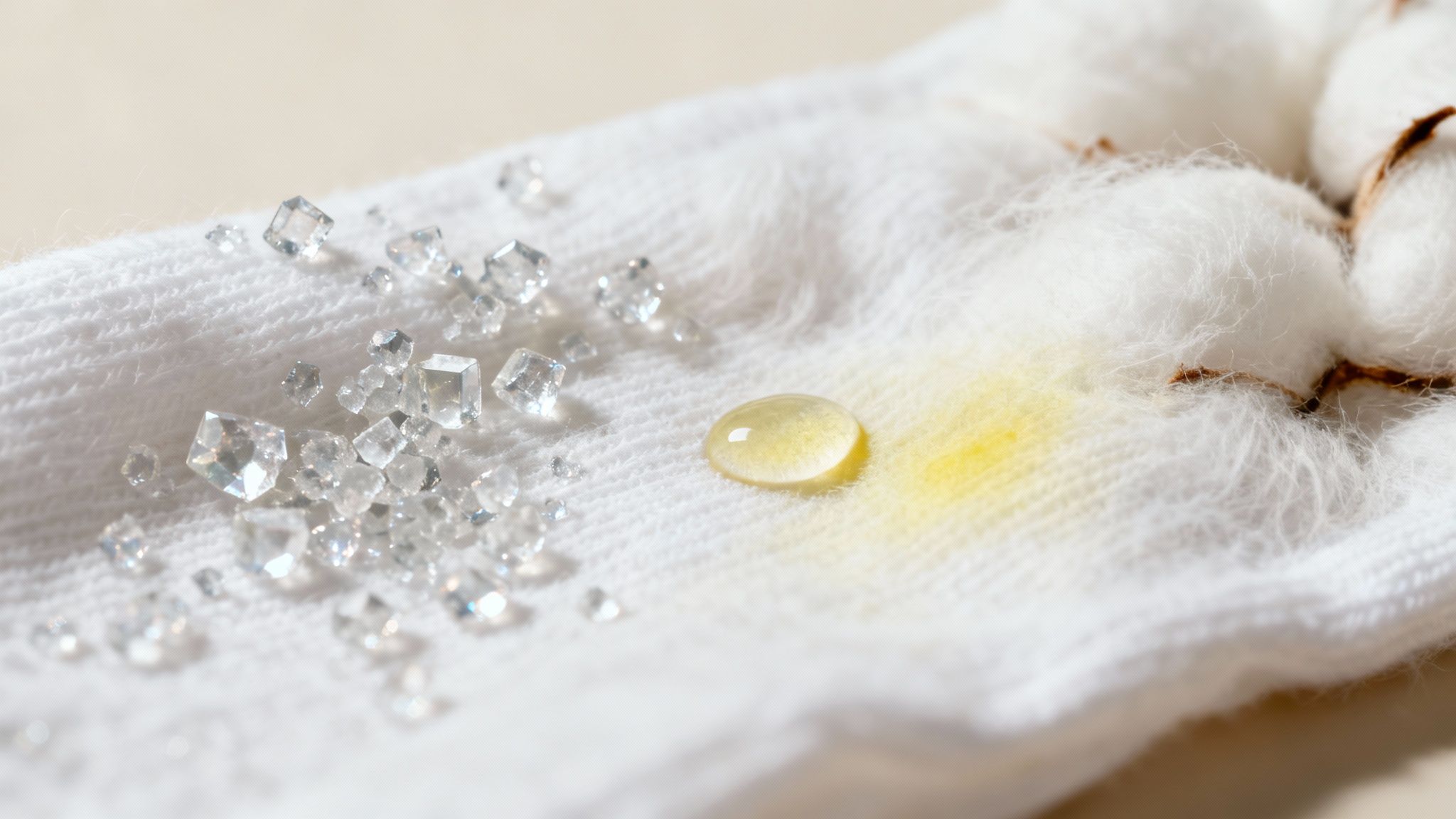
It’s easy to point the finger at your deodorant when those annoying marks show up, but what’s actually happening is a bit of a science experiment in your armpits. Those stubborn stains, especially the yellow ones that ruin white shirts, are the result of a chemical reaction. It’s not just one thing, but a mix of culprits working together.
The main offender in most antiperspirants? Aluminum compounds. These are the ingredients that block your sweat glands to keep you feeling dry. The problem is, when these aluminum salts mix with the proteins in your sweat, they create an entirely new substance.
This new concoction soaks deep into the fibers of your shirt. Over time, it builds up. Then, when you toss your shirt in the wash, the minerals in your water and certain detergent ingredients can react with this buildup, causing it to oxidize and turn that dreaded yellow.
Why Stains Look Different on Colors
You’ve probably noticed that deodorant marks don't look the same on all your shirts. That’s because the same chemical reaction has a totally different look depending on the fabric color.
- On White Shirts: This is where you see the classic yellowing. The reaction between aluminum, sweat, and fabric creates a stain that gets worse over time and can even make the armpit area feel stiff and crusty.
- On Dark Shirts: Those white, chalky streaks you see are a different beast altogether. This is usually just the deodorant product itself rubbing directly off the stick and onto the fabric. It’s a surface-level residue, not a deep-set chemical change in the fibers.
Understanding the science here is the key to actually getting those stains out for good. When you treat the chemical reaction—not just the surface mark—you can bring your clothes back to life and stop future buildup before it starts.
Proven Home Remedies for Deodorant Stains
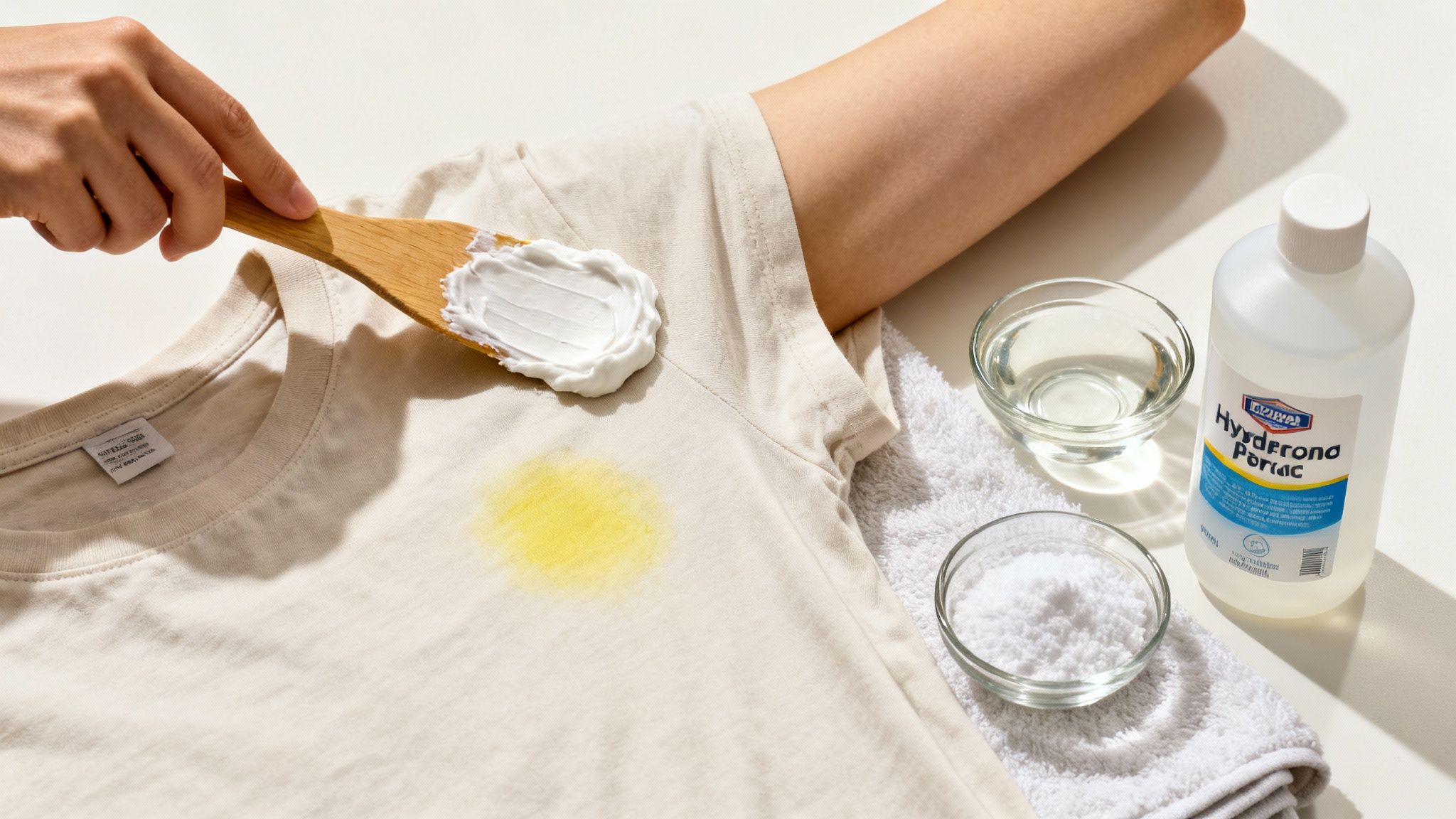
Before you run out and buy a specialized stain remover, take a peek in your kitchen pantry. Chances are, you already have exactly what you need to knock out even the most frustrating deodorant marks. The trick is knowing which tool to grab for which job—each home remedy works a little differently to break down that stubborn buildup.
Sure, the commercial cleaner aisle is massive. The global stain remover market was valued at an eye-watering USD 16.86 billion and is only getting bigger. But sometimes, the simplest solutions are the ones that work best. Many of those fancy products just use the same chemical properties found in ingredients you already own.
The White Vinegar Soak
White vinegar is a total game-changer for breaking down the aluminum salts that cause those stiff, yellowed stains on white shirts. Its natural acidity is perfect for dissolving the minerals and deodorant gunk that have latched onto the fabric fibers.
Just mix equal parts white vinegar and water in a bowl. Dunk the stained part of the shirt into the solution and let it soak for at least 30 minutes, or even a full hour for tougher jobs. After it’s had time to work its magic, give the area a gentle scrub with an old toothbrush before tossing it in the wash like normal.
The Baking Soda Paste Method
For both white and colored shirts, baking soda is a wonderfully safe and effective option. It acts as a mild abrasive, helping to physically lift the deodorant residue from the fabric without causing fading or damage.
Whip up a thick paste by mixing about three parts baking soda to one part water. Smear this paste directly onto the stain, making sure it's completely covered. Now, just let it sit and dry for at least an hour—for really set-in stains, leaving it on longer is even better. Once it's dry and crusty, rinse the paste off with warm water and launder as usual.
If you want a few more tricks up your sleeve, we've got more tips on how to remove antiperspirant deodorant stains you can check out.
Pro Tip: Dealing with a really stubborn yellow stain on a white cotton tee? Combine the two methods for a serious one-two punch. After the vinegar soak, apply the baking soda paste. This tag-team approach is often all it takes to bring your favorite shirt back to its original bright white.
Hydrogen Peroxide for White Shirts Only
When you need to bring out the big guns for yellowing on your white garments, hydrogen peroxide is your go-to. It’s a mild bleaching agent, which is exactly why it’s so effective. And that’s also why you should never use this on colored clothing, as it will absolutely lift the dye and leave you with a blotchy mess.
Mix equal parts hydrogen peroxide, water, and baking soda to create a thin, liquidy solution. Apply it right on the stain and let it sit for about 30 minutes before washing. This potent mix is fantastic at breaking down the chemical bonds that make those deep-set stains so hard to remove.
DIY Stain Remover Playbook
Navigating which home remedy to use can be tricky, but this little cheat sheet should help you pick the right tool for the job.
Remember to always test a new cleaning solution on a small, hidden area of the garment first, just to be safe. With these pantry staples, you'll be well-equipped to handle just about any deodorant mark that comes your way.
Picking the Right Commercial Stain Remover
When your trusty home remedies just aren't cutting it, a trip down the laundry aisle is in order. The shelves are packed with powerful solutions designed for tough stains, but not all of them are built to handle deodorant marks. The trick is to look past the flashy labels and get a feel for what’s actually in the bottle.
For those frustrating yellow pit stains—the ones caused by sweat reacting with the aluminum in your deodorant—an enzyme-based cleaner is going to be your new best friend. These formulas use specific enzymes, like protease, that are literally engineered to break down the proteins and oils trapped in the fabric. It’s a much more targeted attack than your everyday detergent can manage.
If you want to get into the nitty-gritty, you can learn more about the science in our guide on how stain removers work for every stain type.
Sprays Versus Additives
Knowing what kind of product you're grabbing is half the battle. When it comes to deodorant buildup, you’ll mostly see two types:
- Pre-Treat Sprays or Gels: You apply these directly onto the stain before the shirt ever sees the inside of the washing machine. They’re super concentrated, letting the active ingredients soak deep into the fabric fibers to start breaking down the gunk right away.
- Laundry Additives or Boosters: These get tossed into the wash cycle along with your detergent. They're fantastic for giving your whole load a brightness boost or tackling faint, all-over discoloration, but they often lack the concentrated punch needed for set-in armpit stains.
Our Pro Tip: For deep, set-in deodorant stains, a pre-treat spray is almost always the way to go. It delivers a knockout punch of cleaning power exactly where you need it, giving you the best shot at lifting the entire stain in a single wash.
The market for these products is huge, with everything from sprays and sticks to wipes showing up, each designed for slightly different situations. A lot of this innovation is thanks to more people wanting eco-friendly cleaning options, a trend that’s changing both stain removers and the deodorants that cause the problem in the first place.
No matter what you choose, always read the label to make sure it's safe for your fabric. For your colored shirts, find a "color-safe" product or one with an oxygen-based bleach alternative to prevent fading. For your whites, something with optical brighteners can help bring back that crisp, like-new look. Matching the product to the stain and the fabric is the surest way to save your wardrobe and get the results you want.
Simple Habits to Prevent Deodorant Stains

While it's great to know how to tackle deodorant stains, the absolute best strategy is to stop them from happening in the first place. A couple of tiny tweaks to your morning routine can make a huge difference, keeping your favorite shirts looking brand new and saving you from a ton of scrubbing later.
The number one reason for those fresh white streaks is simply wet deodorant transferring directly onto your clothes. We've all been there—rushing to get dressed and out the door. But that's a recipe for marks. Instead, try to give your deodorant a full two to three minutes to dry completely before you even think about pulling on a shirt. That small window of time is often all it takes to prevent the residue from ever touching the fabric.
Key Takeaway: Honestly, patience is your best defense against deodorant stains. Just letting your deodorant fully dry before dressing is the single most effective habit you can adopt to keep your shirts clean.
Choose Your Deodorant Wisely
The kind of product you're using really matters. With the global deodorant market expected to hit a staggering USD 42.19 billion by 2032, manufacturers are rolling out more formulas than ever before. People are looking for more natural and sustainable options, which often means fewer of the harsh chemicals that are notorious for causing stains. You can even read the full market research on this trend.
To cut down on your risk, think about these options:
- Aluminum-Free Formulas: Since aluminum is the main culprit behind those stubborn yellow stains, switching to an aluminum-free product can eliminate the problem at its source.
- Clear Gels or Sprays: These formulas are way less likely to leave behind that chalky white residue you get from solid sticks.
- Apply a Thinner Layer: It’s easy to overdo it, but more isn't always better. A single, thin swipe is all you really need for effective protection, and it leaves less excess product to get on your clothes.
Smart Laundry Habits
Finally, a few simple laundry tricks can stop buildup before it has a chance to set in and become a real problem. Always turn your shirts inside out before tossing them in the wash. This little step lets the water and detergent get right to work on the underarm area where deodorant and sweat tend to accumulate.
Also, be wary of high heat. If you suspect there’s some residue on a shirt, avoid blasting it in the dryer. High temperatures can essentially "bake" the stain into the fabric, making it much, much harder to remove later. For more great tips like these, check out our guide on other simple habits to prevent stains and keep clothes fresh.
Common Questions About Deodorant Stains
It’s totally normal to have a few lingering questions. When you’re staring down a stain on your favorite shirt, you want to get it right. Let’s clear up some of the most common worries people have when tackling deodorant marks.
Can I Get Rid of Old, Set-In Yellow Stains?
Yes, you can, but it’s going to take more elbow grease than a fresh mark. For those stubborn yellow stains that have been around for a while, a good pre-soak is your best friend.
Start by submerging the stained part of the shirt in a mix of one part white vinegar to four parts warm water. Let it sit for at least an hour to really break down the buildup.
Next, mix up a paste using baking soda, a few drops of hydrogen peroxide, and a little water. Gently work this paste into the stain with an old toothbrush. Give it another hour to sit, then toss the shirt in the wash as usual. You might have to repeat the process for really tough, embedded stains.
Will These Methods Damage My Delicate Shirts?
You absolutely need to be more careful with fabrics like silk, rayon, or wool. Stay away from hydrogen peroxide and aggressive scrubbing, as both can easily ruin those delicate fibers.
Your safest bet is a much more diluted white vinegar solution. Just mix one part vinegar with about four parts cool water. Lightly dab the solution onto the stain with a clean cloth—don’t saturate it. After about 15-20 minutes, rinse the area with cool water before gently hand-washing the whole garment.
Pro Tip: Always, always test any new cleaning solution on a hidden spot first. The inside seam or hem is perfect for this. It’s a quick check to make sure you won’t get any surprise discoloration or damage.
Does Switching to an Aluminum-Free Deodorant Actually Help?
It makes a huge difference. The primary culprit behind those tough, yellowed pit stains is a chemical reaction between the aluminum compounds in most antiperspirants, your sweat, and the minerals in your laundry detergent.
When you switch to an aluminum-free deodorant, you take the main troublemaker out of the equation. You might still see some light, chalky white marks from the other ingredients, but these are way easier to wash out and are far less likely to become a permanent, yellowed mess.
Battling stubborn stains is a hassle. If you'd rather spend your time on things you love, let Columbia Pike Laundry handle the hard work. We use professional-grade methods to keep your clothes looking their best. Schedule a pickup today and get your weekend back
Popular Blog Articles

Meet the Author
Daniel Logan didn’t start CPL because he loved laundry. He started it because his family was drowning in time debt, and laundry was one of the biggest weights.
Mornings were chaos with two kids under 5. Evenings felt like catch-up. And weekends? Gone to sorting socks and folding piles.
He knew his story wasn’t unique. So he built a business that gave families like his just a little bit of breathing room one load at a time.
With no laundry experience but deep tech skills, Daniel rolled up his sleeves, doing every job himself while building systems that turned it into a modern laundry service that saves customers time, simplifies their lives, and delivers reliability they can count on.
That’s where CPL began. Not from a playbook, but from pain. From one dad trying to buy back time: for himself, and for every household like his.




